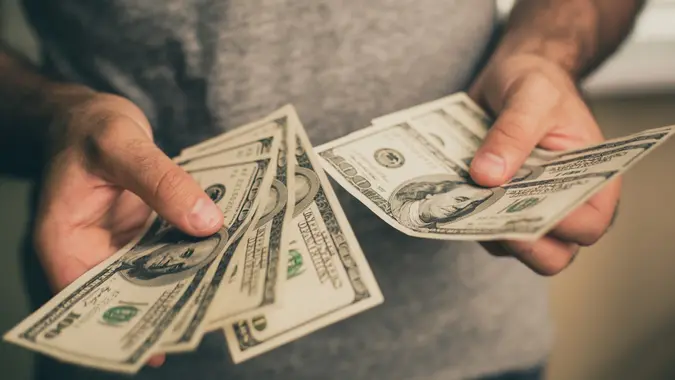What Is Good Deflation and Can It Get Inflation Back To 2%?

Commitment to Our Readers
GOBankingRates' editorial team is committed to bringing you unbiased reviews and information. We use data-driven methodologies to evaluate financial products and services - our reviews and ratings are not influenced by advertisers. You can read more about our editorial guidelines and our products and services review methodology.

20 Years
Helping You Live Richer

Reviewed
by Experts

Trusted by
Millions of Readers
The onset of the COVID-19 pandemic in March 2020 brought an increase in overall inflation that hadn’t been seen in decades — higher demand and lower supply (combined with supply chain issues) all contributed to the sharp rise in inflation.
Fast forward to today, the inflation rate has begun to level out somewhat, with prices down (or at least partially static) and some optimistic economists forecasting a positive economic outlook. But how soon can we reach the Federal Reserve’s target inflation rate of 2%? The rate of deflation will have a lot to do with that.
What Is Deflation?
Simply, “deflation” means falling prices. The Wall Street Journal reported that price deflation is currently limited to appliances, furniture, used cars, and other goods. While economy-wide deflation still isn’t in the forecast, economists predict that the price of goods will continue to fall, which will help bring the overall inflation rate down to the Federal Reserve’s target of 2%. The U.S. Bureau of Labor Statistics indicated that current U.S. inflation hovers around 3.5%.
Good deflation refers to a lowering of prices due to strong demand in the company of an abundance of supply. Meanwhile, bad deflation indicates a lowered price due to a “negative demand shock,” per Quickonomics, which could suggest a weakened economy for some time ahead, as consumers simply cannot afford a category of goods in the first place.
Inflation Still Hasn’t Reached The Federal Reserve’s 2% Target
According to a recent March 2024 Monetary Policy Report from the Federal Reserve: “While inflation remains above the Federal Open Market Committee’s (FOMC) objective of 2%, it has eased substantially over the past year, and the slowing in inflation has occurred without a significant increase in unemployment.”
A tight labor market, sustained low unemployment and more job opportunities — coupled with real GDP growth and increased consumer spending — have helped bring inflation down from a record 10% in late 2022, per the Federal Reserve.
When Will Inflation Reach 2%?
According to Reuters, New York Federal Reserve President John Williams recently explained that he sees inflation reaching 2 to 2.25% sometime later this year, reaching a sustainable 2% in 2025.
That being said, he also explained there could be “bumps” along the way to reach the target inflation rate of 2%.
 Written by
Written by  Edited by
Edited by 

























